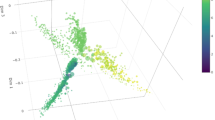Abstract
An important issue in Job Satisfaction analysis is to discover the most important drivers of the workers’ overall satisfaction. This can be investigated by means of data mining techniques able to measure the importance of a covariate in the prediction of a given outcome. Variable importance measures are mainly proposed in the literature in the framework of tree-based learning ensembles, like Random Forests or Gradient Boosting Machine. In this paper a Random Forest variable importance measure is used for mining the drivers of Job Satisfaction in the Social Service sector. In addition an innovative algorithmic procedure is proposed in order to assess the impact of a grouping variable on this variable importance measure. The goal is to investigate if the importance of a Job Satisfaction driver is different for subjects belonging to different groups.
Similar content being viewed by others
References
Aldag RJ, Brief AP (1978) Examination of alternative models of job satisfaction. Hum Relat 31(1): 91–98
Allen RI, Lambert EG, Pasupuleti S, Cluse-Tolar T, Ventura LA (2004) The impact of job characteristics on social and human service workers. Soc Work Soc 2: 173–188
Borzaga C (a cura di) (2007) Quando le risorse umane fanno la differenza: il modello imprenditoriale delle cooperative sociali. Primi risultati di ICSI 2007: la nuova Indagine sulle Cooperative Sociali Italiane. Impresa Sociale, 3,http://www.issan.info/doc/lugset07Impresasociale_colori.pdf
Breiman L (1996a) The heuristic of instability in model selection. Ann Stat 24(6): 2350–2383
Breiman L (1996b) Bagging predictions. Mach Learn 24(2): 123–140
Breiman L (2001a) Random forests. Mach Learn 45(1): 5–32
Breiman L (2001b) Statistical modeling: the two cultures. Stat Sci 16(3): 199–231
Breiman L (2002) Manual on setting up, using, and understanding random forests v3.1, http://oz.berkeley.edu/users/breiman
Breiman L, Friedman JH, Olshen RA, Stone CJ (1984) Classification and regression trees. Chapman and Hall, New York
Brentari E, Golia S (2008) Measuring job satisfaction in the social service sector with the Rasch model. J Appl Meas 9: 45–56
Carpita M (a cura di) (2009) La qualitá del lavoro nelle cooperative sociali, misure e modelli statistici, FrancoAngeli
Carpita M, Manisera M (2008) On the imputation of missing data in surveys with Likert-type scales, Atti del Convegno Metodi, Modelli e Tecnologie dell Informazione a Supporto delle Decisioni. Universitá del Salento, Lecce
Carpita M, Zuccolotto P (2007) Mining the drivers of job satisfaction using algorithmic variable importance measures. In: D’Ambra L, Rostirolla P, Squillante M (a cura di) Metodi, Modelli, e Tecnologie dell’Informazione a Supporto delle Decisioni, parte I: Metodologie, FrancoAngeli
Dietterich T (2000) An experimental comparison of three methods for constructing ensembles of decision trees: bagging, boosting and randomization. Mach Learn 40(2): 139–157
Ferratt TW (1981) Overall job satisfaction: it is a linear function of facet satisfaction?. Hum Relat 34: 463–473
Friedman JH (2001) Greedy function approximation: a gradient boosting machine. Ann Stat 29: 1189–1232
Friedman JH, Popescu BE (2005) Predictive learning via rule ensembles. Technical Report, Stanford University
Gifi A (1990) Nonlinear multivariate analysis. Wiley, Chichester
Manisera M (2005) Measuring job satisfaction by mean of nonlinear Principal Component Analysis, PhD Thesis
Manisera M, Van der Kooij AJ, Dusseldorp EML (2010) Identifying the component structure of satisfaction scales by nonlinear principal component analysis. Qual Technol Quant Manag 7(2):97–115
Rasch G (1960) Probabilistic models for some intelligence and attainment tests. The Danish institute of Educational Research (expanded edition 1980. Chicago: The University of Chicago Press), Copenhagen
Sandri M, Zuccolotto P (2008) A bias correction algorithm for the Gini measure of variable importance. J Comput Graph Stat 17(3): 611–628
Strobl C (2005) Statistical Sources of Variable Selection Bias in Classification Trees Based on the Gini Index. Technical Report SFB 386, http://epub.ub.uni-muenchen.de/archive/00001789/01/paper_420.pdf.
Strobl C, Boulesteix A-L, Zeileis A, Hothorn T (2007a) Bias in random forest variable importance measures: illustrations, sources and a solution. BMC Bioinform 8:25. doi:10.1186/1471-2105-8-25
Strobl C, Boulesteix A-L, Augustin T (2007b) Unbiased split selection for classification trees based on the Gini Index. Comput Stat Data Anal 52(1):483–501
Scarpello V, Campbell JP (1983) Job satisfaction: are all the parts there?. Pers Psychol 36: 577–600
Smith PC, Kendall LM, Hulin CL (1969) The measurement of satisfac-tion in work and retirement. Rand McNally, Chicago
Tenenhaus M, Esposito Vinzi V, Chatelin YM, Lauro C (2005) PLS path modelling. Comput Stat Data Anal 48(1): 159–205
Zuccolotto P (2009) La soddisfazione e l’impegno dei lavoratori delle Cooperative Sociali. In: Carpita M (a cura di), La qualitá del lavoro nelle cooperative sociali, misure e modelli statistici, FrancoAngeli
Author information
Authors and Affiliations
Corresponding author
Rights and permissions
About this article
Cite this article
Zuccolotto, P. Evaluating the impact of a grouping variable on Job Satisfaction drivers. Stat Methods Appl 19, 287–305 (2010). https://doi.org/10.1007/s10260-010-0141-0
Accepted:
Published:
Issue Date:
DOI: https://doi.org/10.1007/s10260-010-0141-0




